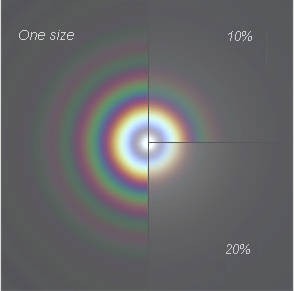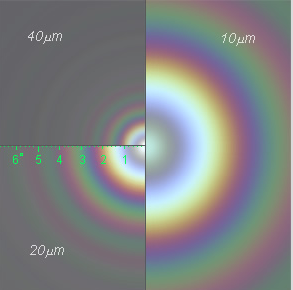The Glory - Effect of droplet size
The Glory: Exploring the Effect of Droplet Size
Atmospheric optics never ceases to amaze with its captivating phenomena. One such phenomenon is the glory, which appears as a series of colorful rings around the shadow of an observer's head. While the glory is a remarkable sight on its own, the size of the droplets that form it can have a significant impact on its appearance. In this article, we delve into the effect of droplet size on the glory, uncovering fascinating details about its formation and characteristics.
The Role of Droplet Size Distribution
A key factor in determining the visibility and clarity of the glory is the distribution of droplet sizes within the cloud. When droplets are monosized, the glory exhibits four or more well-defined rings. However, when there is a range of droplet sizes, the rings become less distinct, reducing their contrast. As the variation in droplet size increases, with a range of 10% or more, all but the innermost ring may be washed out, diminishing the glory's overall appearance.
To better understand this phenomenon, simulations have been conducted using cloud droplets with a normal size distribution around their mean. The percentage figures represent the standard deviations. These simulations have provided valuable insights into the behavior of the glory and how droplet size affects its visibility.
Estimating Droplet Diameter and Glory Size
One way to estimate the diameter of the droplets that form the glory is by considering the relationship between glory size and droplet diameter. Similar to the corona, the size of the glory is inversely proportional to the droplet diameter. To make a rough estimation, one can employ the "outstretched hand" rule. By extending your hand fully at arm's length, the distance between your thumb and little finger tips spans approximately 20°.
Using this rule, you can estimate the glory's diameter and subsequently infer the droplet diameter responsible for its formation. By considering the angular size of the glory and employing basic trigonometry, it is possible to make an approximation of the droplet size, offering valuable insights into the intricate details of this atmospheric optical phenomenon.
Further Considerations for Understanding the Glory
To gain a more comprehensive understanding of the glory and its relationship with droplet size, several additional factors should be taken into account. Exploring these considerations allows for a deeper exploration of this captivating phenomenon:
-
Light Source: The type and characteristics of the light source interacting with the cloud droplets play a crucial role in the formation and appearance of the glory. The angle and intensity of the light source can significantly influence the size and visibility of the rings.
-
Scattering Mechanisms: Understanding the scattering mechanisms involved in glory formation is essential. Multiple scattering events within the cloud droplets contribute to the complex interference patterns that manifest as the glory. Investigating these mechanisms sheds light on the intricate interplay between light and droplets.
-
Atmospheric Conditions: The atmospheric conditions, such as humidity and temperature, can affect the size and distribution of cloud droplets. Exploring how these factors influence droplet size can provide valuable insights into variations in the glory's appearance under different weather conditions.
-
Observation Techniques: Utilizing various observation techniques, such as photography or spectroscopy, can enhance our understanding of the glory's characteristics. These techniques enable detailed analysis of the colors, intensity, and spectral features of the rings, contributing to a more comprehensive understanding of this atmospheric phenomenon.
In conclusion, exploring the effect of droplet size on the glory reveals fascinating details about its formation and characteristics. The distribution of droplet sizes within a cloud can significantly impact the clarity and visibility of the rings. By estimating droplet diameter using estimation techniques like the "outstretched hand" rule, we can gain insights into the intricate details of the glory. Considering factors such as light source, scattering mechanisms, atmospheric conditions, and observation techniques further enriches our understanding of this captivating atmospheric optics phenomenon. So, the next time you encounter a glory, take a moment to appreciate the intricate interplay between droplet size and the mesmerizing rings that adorn the sky.
 Drop size distribution
Drop size distribution
A glory from monosized droplets has four or more rings. A distribution of droplet sizes causes the rings to become less distinct. A variation of 10%. reduces their contrast and all but the innermost ring is washed out when the variation is 20%.
. In the simulations the cloud droplets have a Normal size distribution about their mean. The percentage figures are standard deviations.

Droplet diameter
Like the corona, glory size is inversely proportional to the droplet diameter. Estimate the glory diameter and hence the droplet diameter using the 'outstretched hand' rule. The thumb and little finger tips of a fully outstretched hand held at arm's length extend roughly 20°.
Note: this article has been automatically converted from the old site and may not appear as intended. You can find the original article here.
Reference Atmospheric Optics
If you use any of the definitions, information, or data presented on Atmospheric Optics, please copy the link or reference below to properly credit us as the reference source. Thank you!
-
<a href="https://atoptics.co.uk/blog/the-glory-effect-of-droplet-size/">The Glory - Effect of droplet size</a>
-
"The Glory - Effect of droplet size". Atmospheric Optics. Accessed on November 26, 2024. https://atoptics.co.uk/blog/the-glory-effect-of-droplet-size/.
-
"The Glory - Effect of droplet size". Atmospheric Optics, https://atoptics.co.uk/blog/the-glory-effect-of-droplet-size/. Accessed 26 November, 2024
-
The Glory - Effect of droplet size. Atmospheric Optics. Retrieved from https://atoptics.co.uk/blog/the-glory-effect-of-droplet-size/.